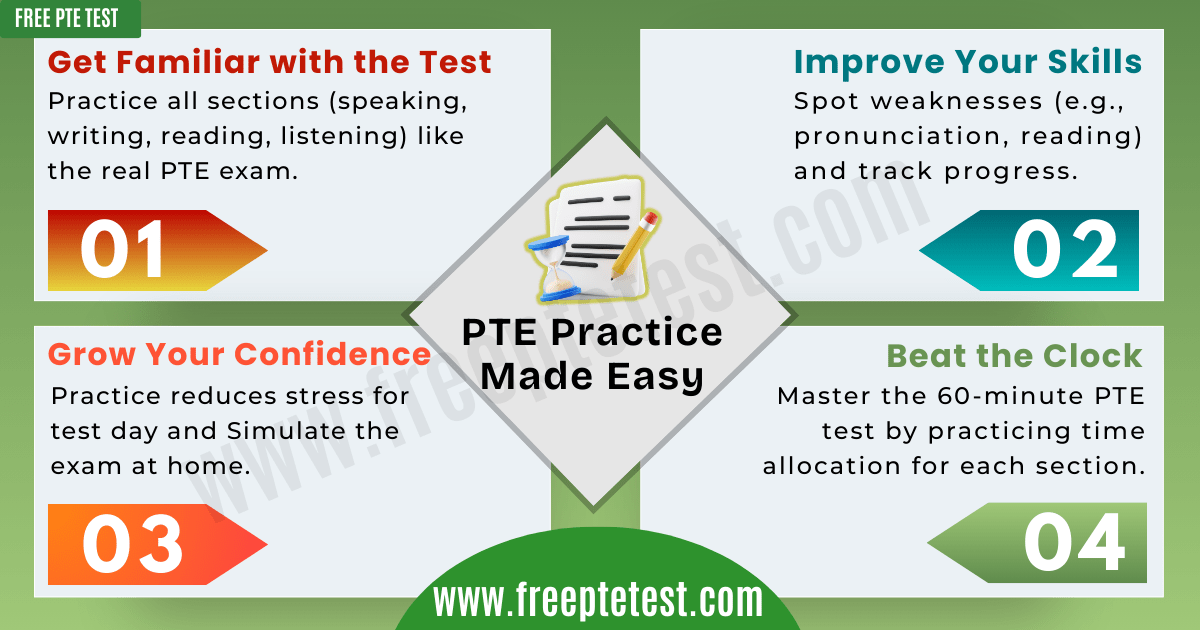PTE Practice Tests are essential tools for preparing for the Pearson Test of English, a globally recognized exam assessing speaking, writing, reading, and listening skills. These tests closely mimic real exam conditions, helping candidates become familiar with the format, manage time effectively, and identify areas needing improvement. Features like AI scoring and instant feedback support continuous learning and confidence building. While mock test scores often reflect actual performance, discrepancies may arise due to differences in scoring systems, technical issues, and test-day pressure. Using high-quality, realistic practice tests and reviewing feedback can enhance exam readiness.
Here is a detailed explanation of above:
The Pearson Test of English (PTE) is a globally recognized English proficiency exam designed to assess the speaking, writing, reading, and listening skills of candidates. Aspiring candidates can enhance their preparation by utilizing PTE practice tests, which simulate real exam conditions and help identify strengths and weaknesses.
It is widely accepted by universities, colleges, and immigration authorities in English-speaking countries. These practice tests are available online, in PDF format, and through specialized apps, offering features like scoring parameters, audio transcripts, and AI-powered evaluations. You can check and PTE Practice Samples, so you may practice accordingly.
Overview of the PTE Exam
The PTE Academic exam is structured into three main sections:
- Speaking and Writing: This section lasts 54–67 minutes and includes tasks such as personal introductions, reading aloud, repeating sentences, describing images, summarizing written text, and essay writing. It evaluates fluency, pronunciation, grammar accuracy, and content knowledge.
- Reading: This section takes 29–30 minutes and assesses comprehension skills through tasks like multiple-choice questions, re-ordering paragraphs, and filling in blanks. It focuses on understanding contextual text and applying grammar effectively.
- Listening: Spanning 30–43 minutes, this section tests auditory comprehension through activities like summarizing spoken text, highlighting incorrect words, filling in blanks, and dictation. It evaluates the ability to process information from various accents and contexts.
Importance of PTE Practice Tests
The Pearson Test of English (PTE) is a widely recognized English proficiency exam, and PTE practice tests play a critical role in effective preparation.
These practice tests not only simulate real exam conditions but also provide valuable insights into a candidate’s strengths and weaknesses.
By regularly engaging with these tests, candidates can familiarize themselves with the exam format, refine their time management skills, and build confidence for the actual test day.
Importance of PTE Practice Tests
- Familiarity with Exam Format
PTE practice tests help candidates become accustomed to the structure, question types, and time constraints of the exam. This familiarity reduces anxiety and boosts confidence, enabling test-takers to approach the exam with clarity and focus.
- Identifying Strengths and Weaknesses
Mock exams provide detailed feedback on performance, highlighting areas that require improvement. For instance, candidates can pinpoint specific sections—such as speaking fluency or reading comprehension—that need additional practice. This targeted approach ensures efficient use of study time.
- Improved Time Management
The PTE exam is time-sensitive, requiring candidates to complete tasks within strict time limits. Practice tests simulate these conditions, helping test-takers develop strategies to manage their time effectively across different sections. For example, practicing skimming techniques in the reading section or quick responses in the speaking section can significantly enhance performance.
- Enhanced Test-Taking Strategies
Through repeated practice, candidates can refine strategies for tackling complex questions, such as summarizing spoken text or essay writing. Detailed answer explanations in practice tests also strengthen critical thinking skills and decision-making during the actual exam.
- Continuous Evaluation
AI-powered scoring systems in online PTE practice tests provide immediate feedback, mirroring the official PTE score report. This allows candidates to track their progress over time and adjust their study plans accordingly.
- Boosting Confidence
Regular practice under real exam-like conditions builds familiarity and reduces test-day stress. Candidates who consistently perform well in mock exams are more likely to feel prepared and confident during the actual test.

Practical Tips for Using PTE Practice Tests
- Utilize online resources or downloadable PDFs with audio transcripts to practice under timed conditions.
- Analyze feedback from mock exams to adjust your study plan.
- Focus on weak areas while maintaining strengths.
- Incorporate vocabulary-building exercises and grammar reviews into your preparation.
PTE practice tests are an indispensable tool for achieving high scores on the PTE exam. They not only enhance preparation but also ensure that candidates approach the test with confidence and competence.
Benefits of PTE Practice Tests:
The Pearson Test of English (PTE) practice tests are an essential resource for candidates preparing to excel in the exam. These tests offer a range of benefits that go beyond simple preparation, enabling test-takers to refine their skills, boost confidence, and achieve high scores. Below is a detailed exploration of the key advantages of PTE practice tests:
- Familiarity with the Test Format
PTE practice tests closely mimic the structure and interface of the actual exam, allowing candidates to become comfortable with its format. This includes understanding question types, navigation tools, and time constraints. Familiarity with these elements reduces test-day anxiety and ensures smooth performance during the real exam.
- Realistic Test Simulation
Practice tests replicate real-time exam conditions, including time limits and scoring systems. This simulation helps candidates experience the pressure of the actual test environment, enabling them to adapt and perform optimally under timed conditions. The realistic nature of these tests builds confidence and minimizes surprises on test day.
- Continuous Evaluation and Instant Feedback
One of the most significant benefits of PTE practice platforms is their AI-powered scoring system, which provides instant feedback on performance. Candidates receive detailed reports highlighting errors, strengths, and areas for improvement. This feedback loop allows for targeted learning and helps candidates track their progress over time.
- Targeted Skill Development
PTE practice tests help identify specific weaknesses in areas such as speaking fluency, writing coherence, or listening comprehension. By focusing on these weak points, candidates can allocate their study time more effectively and work on improving specific skills required for a high score.
- Time Management Skills
Time management is crucial in the PTE exam due to its strict time allocations for each task. Practice tests help candidates develop strategies to pace themselves effectively, ensuring they complete all sections within the given timeframe. This skill is especially important for tasks like essay writing or summarizing spoken text.
- Comprehensive Preparation
These tests provide access to a wide range of questions covering all sections—speaking, writing, reading, and listening—ensuring well-rounded preparation. They also include integrated tasks that evaluate multiple skills simultaneously, mirroring the actual exam’s approach.
- Flexibility and Convenience
Online PTE practice tests are accessible anytime and anywhere, offering flexibility for candidates with busy schedules. This convenience allows learners to integrate preparation into their daily routines without disrupting other commitments.
- Motivation and Confidence Building
Consistent practice using these tools boosts motivation as candidates see tangible progress in their scores over time. The combination of improved performance and familiarity with the test format instills confidence, enabling candidates to approach the exam with a positive mindset.
Practical Tips for Maximizing Benefits
- Use PTE practice tests regularly to track progress.
- Analyze feedback thoroughly to understand mistakes.
- Practice under timed conditions to simulate real exam scenarios.
- Focus on weak areas while maintaining strengths.
PTE practice tests are invaluable for achieving success in the PTE exam. They not only provide a comprehensive preparation framework but also enhance critical skills like time management and targeted learning while building confidence for the actual test day.
Resources for PTE Practice Tests:
Here are some valuable resources for PTE Practice Tests to help you prepare effectively for the exam:
Free and Paid Practice Materials
- FreePTETest: Offers a wide range of free PTE practice materials, including exercises for all four skills (speaking, writing, reading, listening). They also provide free listening practice tests and detailed explanations to help improve specific task types. FreePTETest additionally offers paid coaching courses online for structured learning and personalized feedback.
- YouTube PTE Practice Tests: Channels FreePTETest provide free full-length PTE practice tests with explanations. These videos cover all three sections of the exam and help familiarize candidates with the test pattern and question types6.
Using these resources strategically will help you build familiarity with the PTE exam format, improve your skills across all sections, and boost your confidence for test day.
How effective are PTE practice tests in predicting actual test scores
PTE practice tests are generally effective in predicting actual test scores, but their accuracy can vary depending on the quality of the mock test and the scoring system used.
- Many sources agree that well-designed PTE mock tests provide a good indication of your potential score on the real exam, helping you grasp key concepts and familiarize yourself with the test format.
- Some advanced mock tests, especially those powered by AI scoring systems like Gurully, claim to achieve up to 95% accuracy in predicting actual PTE scores by closely mimicking Pearson’s official scoring criteria. These tests provide instant, unbiased feedback and detailed section-wise performance breakdowns, which help candidates identify strengths and weaknesses effectively.
- However, there are reports from test-takers that mock test scores can sometimes be stricter or less forgiving than the real exam, especially in sections like reading and speaking, which may lead to slightly lower practice scores compared to actual results. This discrepancy can be due to differences in evaluation logic, background noise, or microphone quality in the real test environment.
- The accuracy of a mock test also depends on the experience of the developers and how closely the test content and scoring algorithms replicate the official PTE exam. For example, platforms where developers have personally taken the PTE multiple times tend to offer more reliable score predictions.
- To maximize the predictive value of practice tests, candidates should simulate real exam conditions, use multiple mock tests, and analyze detailed feedback to improve.
What factors can cause discrepancies between mock test scores and actual PTE scores
Discrepancies between mock test scores and actual PTE scores can arise due to several factors:
- Differences in Scoring Systems: Mock tests often use their own scoring algorithms since the exact official PTE scoring criteria are not publicly disclosed. This can lead to variations in how responses are evaluated compared to the real exam.
- Technical Issues: Internet connection quality during online mock tests can affect test performance, especially in listening and speaking sections. Similarly, the quality of microphones and testing devices can impact speaking scores, which may not reflect the actual test environment.
- Familiarity with Question Types: Lack of thorough understanding of specific question formats and task requirements can cause lower scores in the real test if candidates are not well-prepared, even if mock test scores were higher.
- Test Environment and Pressure: The real PTE exam setting, including time pressure and test-day nerves, can affect performance differently than in practice tests, sometimes causing lower actual scores.
- Common Mistakes and Task Execution: Errors such as incorrect grammar, inappropriate tense usage, filler sounds, pausing too long, or not addressing the task prompt fully can reduce scores in the actual exam. These mistakes might be overlooked or less penalized in some mock tests.
- Time Management: Candidates may manage time better in mock tests but struggle to pace themselves during the real exam, leading to rushed or incomplete answers and lower scores.
- Self-Assessment and Feedback Utilization: Not thoroughly reviewing mock test results and failing to address weaknesses identified during practice can cause discrepancies in performance between mock and actual tests.
Discrepancies between mock and actual PTE scores stem from differences in scoring methods, technical factors, test-day conditions, candidate preparedness, and common test-taking errors. To minimize these gaps, candidates should use high-quality mock tests, simulate real exam conditions, focus on understanding task requirements, and carefully analyze feedback to improve.
Summary:
- PTE practice tests simulate real exam conditions to boost preparation.
- They help identify strengths, weaknesses, and improve time management.
- AI scoring offers immediate feedback and progress tracking.
- Differences in mock and actual scores may occur due to scoring methods or test anxiety.
- Regular practice with reliable tools increases confidence and performance.
FAQS:
Q1. What is the PTE exam?
The Pearson Test of English (PTE) is an English proficiency test assessing speaking, writing, reading, and listening skills.
Q2. Why are PTE practice tests important?
They help candidates familiarize themselves with the exam format, manage time, and improve weak areas.
Q3. What features do good PTE practice tests offer?
They include realistic questions, AI-powered scoring, instant feedback, and detailed performance analysis.
Q4. Do PTE practice tests reflect actual exam scores?
High-quality practice tests can predict actual scores accurately, but slight variations may occur.
Q5. What causes score differences between mock and real PTE tests?
Scoring algorithm differences, technical issues, test-day pressure, and user errors can impact scores.
Q6. How can practice tests improve time management?
By simulating timed conditions, they help candidates develop pacing strategies for each exam section.
Q7. Are free PTE practice resources available?
Yes, platforms like FreePTETest offer free practice materials and full-length mock tests online.
Q8. How often should I take PTE practice tests?
Regularly taking them helps monitor progress and adjust study plans based on feedback.
Q9. Can mock test scores be higher or lower than real PTE scores?
Yes, due to stricter scoring in mock tests or test-day variables affecting real performance.
Q10. What’s the best way to use PTE practice tests effectively?
Practice under timed conditions, analyze feedback, focus on weak areas, and simulate exam-like environments.



